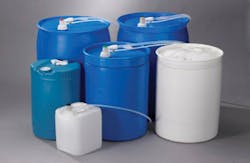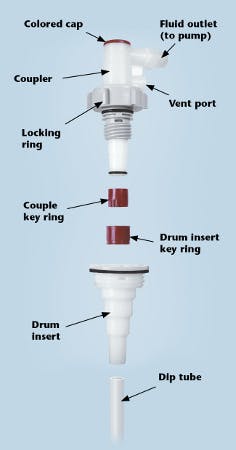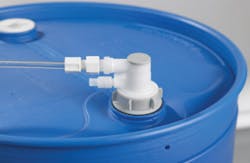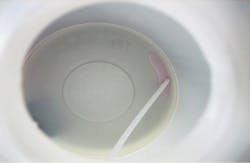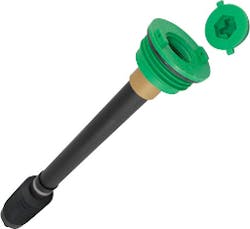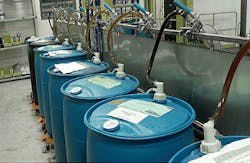At any given time, there are millions of liquid-filled drums and IBC totes in circulation around the world, transporting everything from edible oils and flavorings to detergents and solvents or other hazardous media. These containers provide industries an efficient way to deliver bulk liquid ingredients and products from the producers/manufacturers and blenders who package them to the end users, who, in turn, need to transfer the liquids into smaller containers or into equipment for end-use processes.
Historically, the simplest transfer method has been through an open dispensing system by simply pouring the liquid out of the original shipping container into a bucket using a spigot. This method, however, is typically messy and risks splashes and spills that expose workers and the environment to potential hazards from the liquid media, as well as the fumes they generate.
Another common method used in many industries employs a semi-closed dispensing system where a stinger-type dip tube draws the contents out of a vertically oriented container using an attachable hand or electric/air-driven screw-type transfer pump.
While this approach is a step in the right direction, the semi-closed dispensing system is typically not sealed and allows potentially dangerous fumes from the chemical to pollute the atmosphere in the work space. In addition, the semi-closed approach requires workers to insert and remove a dip tube each time a new drum is emptied—a process that still exposes them to drips, leaks, and fumes during the transfer.
A third liquid-dispensing approach is the closed or sealed system, and this is a significantly safer approach than either the open or semi-closed methods. Closed systems rely on a pump to draw the media from the container and deliver it to the end process.
Closed systems include three main components:
- Dip-tube assembly: This assembly usually includes a drum insert with a threaded plug that replaces the standard bung plug and a hollow down tube or straw that extends to the bottom of the container. The dip tube is pre-installed by the drum manufacturer or the packager of the contents at the time of filling. Alternately, the end-user may choose to install the dip tube in a safe area prior to delivering the container to the end process location.
- Dispense head or coupler: This is a connector that can be easily affixed to the container to facilitate dispensing of the media at the end user’s site. The coupler will be connected to a pump using hose or tubing of some sort that feeds the end-user’s process.
- Pump: Virtually any type of pump (centrifugal, diaphragm, gear, vane, peristaltic, metering, proportioning, etc.) can be used with a closed system since a properly designed system will allow for connection to any pump inlet.
Virtually any industry can benefit from closed system dispensing of both hazardous and nonhazardous liquids because there are multiple advantages for manufacturers, shippers, packagers, and end-users alike. Below are 10 reasons you may want to adopt or specify closed system dispensing for your bulk liquid containers.
1. Ensure Worker Safety
Closed-dispensing systems are safer for workers because they eliminate exposure to hazardous liquids during storage, transfer and disposal. OSHA, along with other health and safety organizations, is taking aggressive steps to minimize the chances of chemical exposure for personnel and the work environment. These increased safety concerns are driving the trend toward systems that prevent worker contact with chemicals.
Because a closed system means the dip tube is pre-installed in the drum, there is limited opportunity for contact between the container contents and the worker or the environment. As a further protection, the dip-tube assembly can be specified with various styles of shipping plugs to safely deal with internal pressure created in the container resulting from either high vapor pressure media or from changes in altitude or temperature that are different from those present during filling.
2. Maintain Purity of Contents and Prevent Degradation
Many industries and applications require chemicals to be transported and dispensed in a closed manner to prevent any possibility of contamination. The semiconductor and life sciences industries were among the first to implement completely closed systems. In these industries’ highly sensitive manufacturing processes, the presence of even the smallest amount of dust or foreign material can prove extremely costly. A closed system controls chemical purity from the point-of-origin through contents transferred and all the way to the point-of-use.
3. Maximize Materials use for Cost-Efficiency
A well-designed closed dispensing system will also enable complete (99-plus percent) emptying of a drum or IBC tote, allowing for the most efficient use of the materials for which the end user has paid. This is especially important when drum contents are costly or if contents are hazardous, which makes disposal difficult and/or costly. Two methods are typically employed to achieve this near-100 percent dispensing of contents:
- 1. A flexible dip tube, made slightly longer than the drum height, will bend and work its way into the outer edge in the bottom of a drum during installation (Figure 4). Then, when the drum is almost empty, a simple shim can be inserted under the opposite side of the drum to maximize emptying.
- 2. An accordion-type bellows device is affixed to the bottom of the dip tube in order to maintain contact between the bottom of the drum and the dip tube (Figure 5).
Both methods are effective in maximizing emptying efficiency, reducing waste, and minimizing the costs associated with disposal. However, the accordion bellows costs more because it requires: an additional component (the bellows); a much larger/stiffer dip tube in order to compress the accordion bellows; and additional labor to assemble the bellows element to the dip tube.
4. Prevent Possible Misconnections
Optional features available on some closed dispensing systems help prevent misconnections. Options include color coding, physical keying, and use of radio frequency identification (RFID) technology or all three. Colored caps can be placed on the coupler and installed in the dip-tube assembly to make it easy to match the coupler with the right drum or IBC tote. In applications using multiple drums containing different products, color coding can minimize the potential for misconnections that could damage processes or lead to costly contamination.
5. Reduce Cleanup Costs
By eliminating spills at the point-of-use, closed dispensing systems also eliminate costly and sometimes dangerous cleanups. Not only can a closed system prevent direct costs associated with cleanups, but it prevents productivity losses by eliminating the need to divert personnel from more important activities related to production. Moreover, because the drum and dip-tube assembly can usually be recycled as a unit, no labor or water resources are required for drum cleaning and there is no contribution to the water waste stream.
| Key Features of a Closed Dispensing System |
Ideally the coupler between the drum head and the end-user’s tubing will incorporate four main features:
|
6. Reduce Disposal Costs
Polyethylene drums or IBC totes featuring pre-installed polyethylene dip-tube assemblies create a complete package that can be filled and emptied safely and completely, and recycled as a unit. Once a drum is emptied and the shipping plug is inserted in the dip-tube assembly, the package is ready to safely ship to a recycler. With closed dispensing systems’ ability to remove up to 99.9 percent of the contents of a drum, any additional costs associated with hazardous waste disposal may be avoided or reduced.
7. Support Sustainability Initiatives
Many companies today have made formal commitments to environmental and social responsibility; and using closed system chemical dispensing technology can contribute to these goals by helping organizations achieve:
- Zero occupational illnesses
- Zero discharges into the environment
- Zero reportable incidents of any kind
- Continuous improvement in energy and water use efficiencies
- Continuous reduction of absolute waste, energy, and water use
- Intentional design of products to be reusable, recyclable, or made from renewable materials
- Delivery of safer solutions that meet the needs of customers and society.
Selecting and Installing Closed System Dispensing
The decision to use closed system dispensing can be made by the drum or IBC tote manufacturer, the chemical manufacturer, or even the end-user. For drum and IBC tote manufacturers, low-cost dip-tube assemblies can be pre-installed in empty containers prior to shipping them to a customer; or a chemical packager can install them in containers filled with liquids prior to shipping containers to a customer. Even end-users with the facilities to safely handle materials may choose to install the dip tubes on-site just prior to use. No matter at what stage an integrated closed dispensing system is implemented, the ideal system will be one that protects people and the environment from chemical exposure, is easy to use, and improves profitability for all parties—drum manufacturer, chemical packager, and end-users alike.
8. Ship with Un/Dot Approval
When a Jerrican, drum, or IBC tote is used to transport hazardous materials (HAZMAT) as defined by the Environmental Protection Agency (EPA, www.epa.gov), the package (container plus closures) must pass the DOT’s testing regimen as defined in CFR 178 to verify that the contents will be secure during transport. This holds true when the closure is a pre-installed dip tube. Packagers can choose dip-tube assemblies that meet these standards.
9. Meet Cleanroom Application Needs
Industries with strict cleanroom manufacturing standards (such as the semiconductor, solar, and life sciences industries) can benefit from closed system dispensing because dip-tube assembly and coupler components can be assembled under cleanroom conditions that adhere to specific application requirements. Plus, the resulting closed system dispensing unit helps guarantee content purity from the point-of-origin to the point-of-use.
10. Control Costs
While convenience and safety are both important goals for liquid dispensing, affordability is also critical. That is why the drum inserts and dip tubes of DrumQuik are constructed almost entirely from high-density polyethylene (HDPE). HDPE is inexpensive and an FDA grade that is suitable for food processing. It combines ruggedness with resistance to a very wide range of industrial chemicals. And since most Jerricans, drums, and IBC totes are also made of HDPE, the whole assembly is easily recycled. For high-volume users of HDPE containers, the cost savings and return on investment of closed system dispensing can be realized very quickly. For other applications that require dip tubes or couplers made of stainless steel or exotic polymers, the materials price will be significantly higher, but the other benefits of closed system dispensing might still outweigh the cost.
A Closing Argument for Closed Dispensing Systems
Today, chemical packagers and end-users—well aware of the liabilities they face—are increasingly incorporating closed systems into their chemical management solutions, both in hazardous and non-hazardous industries. Closed dispensing systems that utilize a pre-installed dip-tube assembly in a single-trip drum are inherently safer, and they can also be rugged, reliable, and affordable. This last attribute, affordability, is often the key determinant as to whether these safe and convenient systems are implemented widely or at all.
While open and semi-open systems will continue to be employed, drum manufacturers can improve customer acceptance of their products by offering a low-cost closed dispensing system with a pre-installed dip-tube assembly. Likewise, packagers can enhance both safety and the acceptance of their products by offering pre-installed dip tubes that mate with coupler types favored by the end-users. Finally, end-users gain benefits from closed dispensing systems that include greater worker and environmental safety, improved container emptying efficiency, reduced cleanup/disposal, costs and contributions to sustainability and a cleaner world.
Thomas A. Braun is the business manager of chemical and packaging products for Colder Products Company in St. Paul, Minn. With Colder for more than 20 years, he currently oversees business development efforts, assesses new market opportunities, and develops program initiatives, including technology licensing, patent evaluations, and contract negotiations. He developed and co-patented the pressure balanced non-spill coupling design and DrumQuik dispensing connector system for Colder, both of which have won several industry awards. Prior to joining Colder, he served in design engineering and mechanical research and development management roles at Tectonics Research Inc. and Advanced Compressor Technologies. He helped develop an efficient heat pump while at Advanced Compressor Technologies, and he also developed and patented a natural gas direct-injection system for two-stroke internal combustion engines. He holds a bachelor’s degree in Mechanical Engineering from Gannon University in Erie, Penn., has three patents, and is involved in various industry associations. Mr. Braun can be reached at [email protected].

